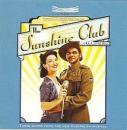AustLit
Latest Issues
AbstractHistoryArchive Description
Production Details
-
First produced at the Cairns Civic Theatre, 4 November 1999 and then produced by the Sydney Theatre Company at the Drama Theatre, Sydney Opera House, 15 January - 26 February 2000.
Director: Wesley Enoch.
Choreographer: Stephen Page.
Composer: John Rodgers.
Designer: Richard Roberts.
Lighting Designer: Matthew Scott.
Musical Director: Wayne Freer.
Cast: Wayne Blair, Elaine Crombie, Roxanne McDonald, Christen O'Leary, David Page, Tessa Rose and Ursula Yovich.
Presented by Queensland Theatre Company, 9-30 July, Playhouse, QPAC.
Director: Wesley Enoch.
Publication Details of Only Known VersionEarliest 2 Known Versions of
Works about this Work
-
Rectifying 'the Great Australian Silence'? Creative Representations of Australian Indigenous Second World War Service
2012
single work
criticism
— Appears in: Australian Aboriginal Studies , no. 1 2012; (p. 35-48)'Until the publication of Robert Hall's landmark book The Black Diggers in 1989, Aboriginal and Torres Strait Islander people were essentially 'written out' of Australia's Second World War history. Still, more than 20 years since the publication of Hall's book, Australian Indigenous participation in the war effort as servicemen and women, labourers and scouts, in wartime industries and in various other capacities, continues to be on the periphery of Australia's war history. The Second World War remains part of what WEH Stanner referred to in 1969 as 'the Great Australian Silence' of Indigenous history. Notwithstanding the lack of significant academic histories of Indigenous military history, there have been a few creative depictions of Aboriginal participation in the Second World War. Both Indigenous and non-Indigenous people have used creative mediums, such as poetry, short fiction, film, musical theatre and music, to portray Aboriginal Second World War service. This paper examines these creative cultural representations and how they position Australian Indigenous war service within a wider narrative of the Second World War and Indigenous history. Though the portrayals of Aboriginal service vary, the majority of creative works present the Second World War as central to Australian Indigenous history. Moreover, the creative representations depict Indigenous servicemen's hopes for a better life after the war, only to be crushed when they returned to ongoing discrimination. Even so, the creative depictions use the Second World War as an early marker of reconciliation in Australia, portraying the conflict as a time when ideals of liberty and equality overruled prejudice to unite Australia. Such a message continues to resonate, as creative representations of the Second World War contribute to contemporary understandings of Aboriginal and Torres Strait Islander citizenship and reconciliation.' (Publication abstract)
-
Rectifying 'the Great Australian Silence'? Creative Representations of Australian Indigenous Second World War Service
2012
single work
criticism
— Appears in: Australian Aboriginal Studies , no. 1 2012; (p. 35-48)'Until the publication of Robert Hall's landmark book The Black Diggers in 1989, Aboriginal and Torres Strait Islander people were essentially 'written out' of Australia's Second World War history. Still, more than 20 years since the publication of Hall's book, Australian Indigenous participation in the war effort as servicemen and women, labourers and scouts, in wartime industries and in various other capacities, continues to be on the periphery of Australia's war history. The Second World War remains part of what WEH Stanner referred to in 1969 as 'the Great Australian Silence' of Indigenous history. Notwithstanding the lack of significant academic histories of Indigenous military history, there have been a few creative depictions of Aboriginal participation in the Second World War. Both Indigenous and non-Indigenous people have used creative mediums, such as poetry, short fiction, film, musical theatre and music, to portray Aboriginal Second World War service. This paper examines these creative cultural representations and how they position Australian Indigenous war service within a wider narrative of the Second World War and Indigenous history. Though the portrayals of Aboriginal service vary, the majority of creative works present the Second World War as central to Australian Indigenous history. Moreover, the creative representations depict Indigenous servicemen's hopes for a better life after the war, only to be crushed when they returned to ongoing discrimination. Even so, the creative depictions use the Second World War as an early marker of reconciliation in Australia, portraying the conflict as a time when ideals of liberty and equality overruled prejudice to unite Australia. Such a message continues to resonate, as creative representations of the Second World War contribute to contemporary understandings of Aboriginal and Torres Strait Islander citizenship and reconciliation.' (Publication abstract)
- 1946



